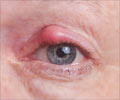Checking corneal nerve damage in type 2 diabetes patients can detect progressive nerve damage in the whole body early, finds a new study. Progressively Type 2 diabetes can impair nerve function in the body.
Highlights
- By means of a corneal examination, progressive nerve damage usually caused in type 2 diabetes can be detected early.
- Type 2 diabetes can lead to impaired nerve function, half //of those who have had type 2 diabetes for more than ten years have a decrease in nerve functions, which usually begins in their feet.
- Although there is currently no cure to treat the progressive nerve damage, it is beneficial to detect the damage early.
TOP INSIGHT
By examining the cornea of the eye with a special microscope it is possible to diagnose if the nerve damage has already started in a person with type 2 diabetes. This method may take only take 10 minutes.
When type 2 diabetes develops, small nerve fibers in the peripheral nervous system begin losing their function even before symptoms become apparent. These small peripheral nerve fibers are found in the skin, but also in the cornea of the eye. Because the cornea is transparent, it is an ideal place to study nerve damage that occurs in diabetics.
In the study with 82 people from Skelleftea, with or without type 2 diabetes, the participants' eyes were examined with a special microscope. The study found that the corneal nerve density was lower in individuals with type 2 diabetes compared to healthy subjects. If the individual had had type 2 diabetes for a longer period of time, nerve density was even more reduced.
The study is the first of its kind in Sweden. Through cooperation between a Swedish research team and researchers in Germany, Italy, and Norway, a method has been developed to create images in three dimensions of corneal nerves. The examination only takes ten minutes and does not cause any discomfort to the patients. The research team has also developed an automated analysis programme that allows the method to be used in general health care. Microscopic examination of the cornea occurs internationally, but the Skelleftea study is the first in the world to use the entire new method for assessing the degree of nerve damage in diabetics.
"There are good conditions for this new diagnostic method to be widely introduced in health care," says Olov Rolandsson.
Reference
- Neil S. Lagali; Stephan Allgeier; Pedro Guimarães; Reza A. Badian; Alfredo Ruggeri; Bernd Köhler; Tor Paaske Utheim; Beatrice Peebo; Magnus Peterson; Lars B. Dahlin; Olov Rolandsson. Reduced Corneal Nerve Fiber Density in Type 2 Diabetes by Wide-Area Mosaic Analysis, Investigative Ophthalmology & Visual Science (2018).DOI:10.1167/iovs.17-22257
 MEDINDIA
MEDINDIA





 Email
Email










